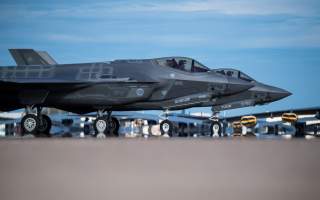Introducing Russia's S-500: Can It Take Out an F-22 or F-35?
What you need to know.
Prospective clients may lose interest in the S-400 if they come to believe that it’s on the verge of obsolescence.
2019 is on track to be a big year for Russian surface-to-air missile systems. From the new S-350 “Vityaz” to additional S-300V4 brigades, scores of modernized Russian artillery systems are poised to enter into military service over the coming months.
(This first appeared earlier in the year.)
But the elephant in the room, Russia’s upcoming S-500 “Triumfator-M” missile system, remains conspicuously absent.
The much-vaunted next generation of Russian missile defense, the S-500 boasts a host of best-in-class performance features. The Triumfator is purportedly able to engage anti-ballistic missiles at six hundred kilometers, an improvement of two hundred km over the already-formidable S-400. The S-500’s range is matched by its no less impressive ability to track and intercept up to ten missile warheads flying at a speed of over 4 miles a second, as previously outlines by a National Interest report citing Russian state news.
Considerably less concrete information is available on the S-500’s armaments suite. Initial leaks suggested modified NPO 9M82MD anti-aircraft missiles, but later reports have settled on the S-400’s 48N6 line as the likelier prospect. As for anti-missile options, the S-500 is widely believed to feature specially designed 77N6 and 77N6-N1 missiles.
Russian media and military experts believe that the S-500 will be the first missile defense system able to reliably target and neutralize fifth-generation stealth fighters like the F-35, a claim too early to meaningfully evaluate at this stage in the S-500’s development cycle.
“The S-500 is a blow against American prestige,” Almaz-Antey head engineer Pavel Sozinov told Russian media. “Our system neutralizes American offensive weapons, and surpasses all of America’s much-hyped anti-air and anti-missile systems.”
The S-500 rests on impressive specifications and ambitious manufacturer claims, but not all is well in Russian missile defense paradise. Triumfator-M was first declared to be completed in 2011, with serial production to begin in 2014. That date was promptly pushed back to mid 2017, and then again to 2020.
So, what accounts for these almost cyclical delays? The most immediate cause that springs to mind are development troubles, and for good reason; unexpected, costly technical hitches on the heels of wildly-optimistic deadlines are an all too common story in strategic weapons development.
Russian sources remain tight-lipped concerning the S-500’s development, let alone on any possible technical problems. Still, recent reports have offered an alternative explanation: The S-500 is virtually complete, but the Kremlin is dragging their heels for commercial reasons. That is, they are afraid that releasing the S-500 would poach on the massive export success of the S-400.
Prospective clients may lose interest in the S-400 if they come to believe that it’s on the verge of obsolescence. Strategically vital clients like Turkey and India may very well be annoyed that they crossed major US diplomatic hurdles only to buy expensive S-400 systems that will be outdated by the time of delivery.
Further compounding the problem, Russia will want to proliferate the S-500 among their own armed forces before offering it to foreign buyers. Concrete S-500 export plans remain a distant blimp on the horizon, an impossibility until 2021 even in the best of circumstances. The Kremlin therefore risks not only jeopardizing ongoing S-400 deals, but doing so with no immediate substitute to offer. By this line of reasoning, The Kremlin shot itself in the foot by revealing the S-500 too early, and is now stalling until the S-400 reaches the end of its market cycle.
At a time when Russia’s preferred approach for defending beleaguered projects is to go on high-profile marketing offensives (See their recent documentary series on the Su-57 as a case in point), this theory explains why the Kremlin has been so uncharacteristically silent about the S-500. It also aligns with the underlying goals behind Russia’s arms export strategy: if they want to foster stable, long-term trade relationships with key buyers like Turkey, then they have to go out of their way to show that they stand behind their product.
Mark Episkopos is a frequent contributor toThe National Interest and serves as research assistant at the Center for the National Interest. Mark is also a PhD student in History at American University.

